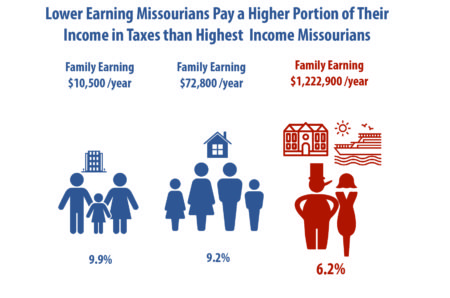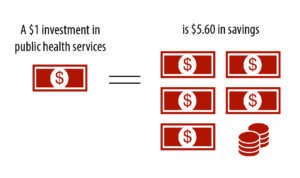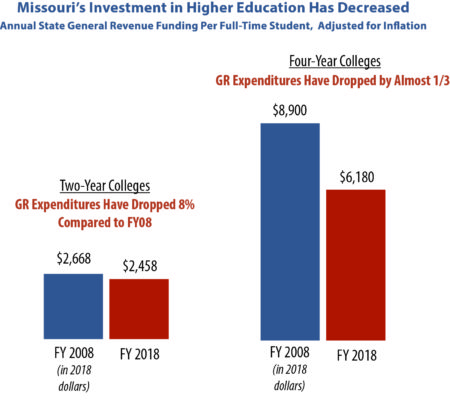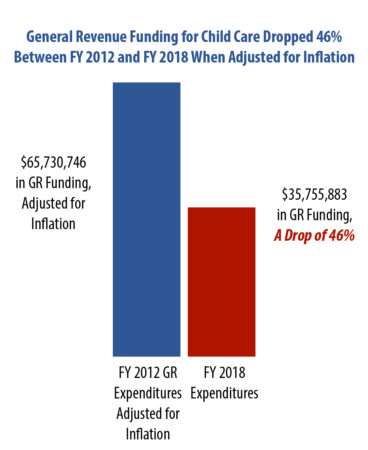Download the PDF Version
Missouri’s Tax Structure is Unfair & Inadequate
When Missourians have access to the resources that help them succeed in life, such as quality health care, education, and childcare, we are all stronger as communities, and as a state.
Yet Missouri is falling behind. Decades of poor tax policy decisions now mean that Missouri doesn’t invest in its communities like most of the nation, or surrounding states. Only four states in the nation collect less state revenue per capita than Missouri.
- Each year Missouri gives away over $1 billion in special corporate giveaways and tax loopholes leaving our communities strapped, struggling to provide the most basic services to strengthen their communities.
- What’s more, low- and middle-income Missourians pay a higher proportion of their income in state and local taxes to support these services than do their wealthy counterparts.
- Missouri’s recent tax cuts go disproportionately to higher income Missourians, leaving the middle-class holding the bag.
These decisions have consequences, just a few of which are discussed in the following pages.
While the effects of Missouri’s eroded revenue are widespread, these issues give a snapshot of how Missouri stacks up against its neighbors.
Mental Health
When our neighbors, co-workers, and family are able to lead productive, healthy, and independent lives we all benefit. Yet many Missourians, particularly low-wage workers, are unable to access the care they need in order to thrive.
Missouri’s restrictive Medicaid eligibility is a significant barrier to treatment for those living with mental illness or substance abuse problems.
Medicaid eligibility for parents in Missouri is the third lowest in the nation.
Adults without children are ineligible entirely.
For instance, a mother with two children would not be eligible for Medicaid if she makes more than 22% of the federal poverty level – that’s just $385 per month for a family of three.
- The national average is now 138% of poverty, or an income of $2,453 for the same family.
- This is a substantial barrier to treatment for over 183,000 Missourians who live with mental illness.
- In fact, over 1 in 4 Missourians with mental illness report they are not able to access needed treatment, a rate higher than every other state in the nation.

- The cost of this lack of access to appropriate care is passed on through higher crime rates and unnecessary and costly incarceration.
Public Health
Investments in public health not only contribute to healthier neighborhoods, workplaces, and schools, but also save our state approximately $5.60 for every dollar spent.
Yet, state funding for core public health services provided through Missouri’s local health departments was cut by nearly 2/3 between FY 2002 and FY 2018.
Missouri’s per capita investment in the state public health budget is currently the lowest in the nation.


- The decline in public health funding over time is a direct result of budget cuts spurred by Missouri’s unfair tax policy.
- In order to plug gaps in the Missouri budget, general revenue funding for Missouri’s local health agencies has largely been replaced with earmarked federal dollars. However, these funds may only be used for specific purposes, which may not be the ones most urgently needed in local communities.
Higher Education
Higher education is a critical component in developing a skilled and educated workforce that contributes to a better economy and shared prosperity for all Missourians.
But in FY 2017, Missouri invested only $166 per capita in state funding (both general revenue & earmarked funds) for higher education.
This is below all of our neighboring states, and more than one-third below the national average of $269.
Missouri ranks 45th in the nation in per capita state fiscal support for higher education.

As state funding for higher education has declined, costs for families have increased.
- Since 2010, tuition and fees at Missouri’s four-year institutions have increased by nearly 20%, while tuition at two-year colleges has increased by nearly 40%.
- Yet these tuition increases have not kept pace with the real cost of providing higher education, meaning that the effects of reduced state funding are felt directly by students through fewer course offerings and increased class sizes.
K-12 Education
A quality education is critical to the long-term health, economic stability, and well-being of our children, our local communities, and our state.
But Missouri’s state funding for local schools (both earmarked and general revenue) was less than half the amount spent by Kansas, and more than 1/3 below the national average.
Missouri ranks 46th in the nation in state revenue dedicated per K-12 student.
The $31,842 average starting salary for a teacher in Missouri is lower than all but one other state.
This lack of state funding means school districts rely heavily on local funding, which exacerbates inequity. Only two states and the District of Columbia rely more heavily on local funding.
School districts in high poverty areas have a limited ability to fill gaps in funding with local resources, while also serving students who are more costly to educate given higher rates of disability, homelessness, hunger, and other factors that impact a student’s ability to learn.

As a result, Missouri has the second most regressive educational funding system in the nation, with students in high poverty districts receiving nearly $1,800 per student less than their counterparts in more affluent districts.
Senior Services
When older Missourians have access to supports that help them age in their own homes and communities, they can live with dignity as they age. Yet in recent years, programs designed to help keep Missouri’s seniors at home have been substantially cut or underfunded. These cuts are taking place as the number of Missouri seniors will soon increase substantially.
Missouri ranks 45th in the nation in the adequacy of policies designed to support seniors.

- Between 2010 and 2040, the share of Missouri’s population that is aged 65 or older will grow by 53%, and the share of the population 85 or older will grow by 69 percent.
- Missouri remains unprepared for the challenges this will present to the state budget.
Child Care
Missouri’s child care assistance program helps parents with low wages go to work by helping to provide access to quality child care. But low eligibility limits for this assistance, plus low reimbursement rates for providers, leaves big gaps in accessing care.
Missouri has the 8th lowest eligibility for child care assistance in the nation.

Only seven states have a lower eligibility threshold for child care assistance than Missouri.
- Full child care assistance for Missouri families ends at just 138% of the federal poverty level, or just $2,453 per month for a family of three.
- This eligibility is well below the national average of 180%, and lower than all neighboring states except Nebraska.
- Missouri’s payment rates for child care providers who care for children through the subsidized child care program are among the lowest in the nation. Reimbursement rates are well below market rates, in some cases as low as 51% of the cost of care.
- In practice, this shifts cost to low-wage parents, who either pay high fees to make up the difference or are rejected outright by center who will not accept the subsidy.
- Other working parents also pay the price through a lack of affordable, high quality child care providers throughout Missouri.

